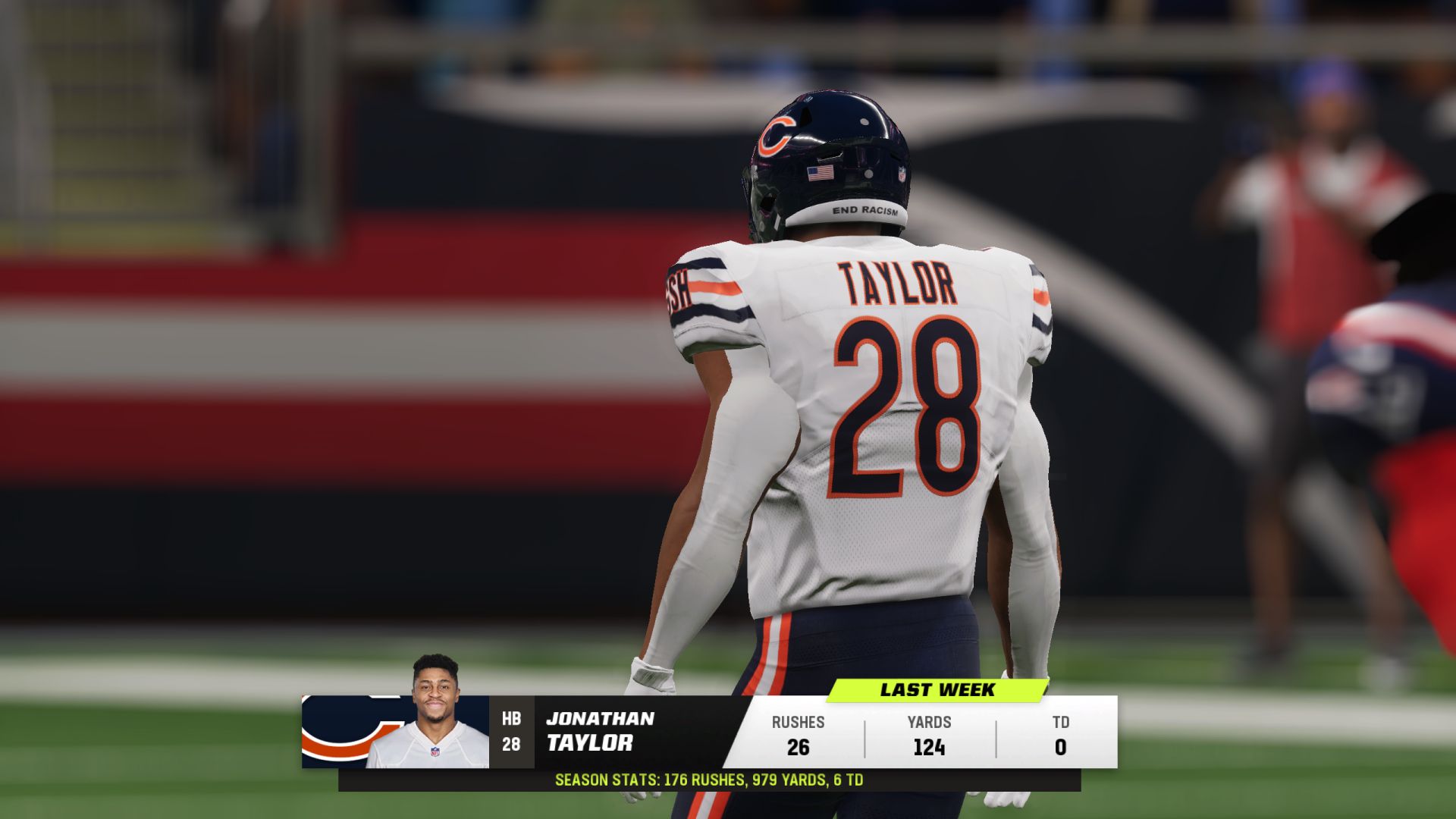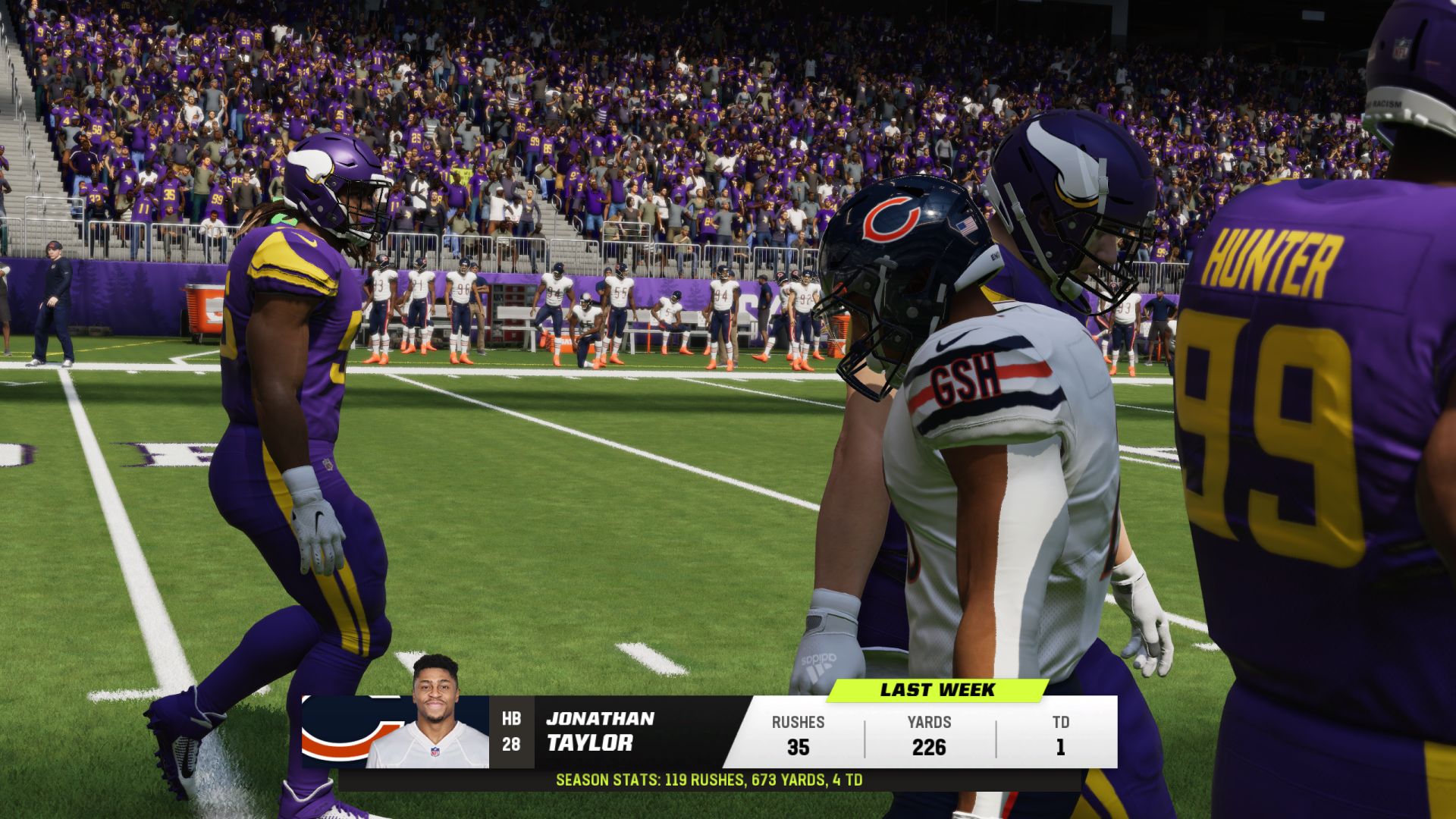I played an entire season in Madden 23 without throwing a single pass
Pass over

How many games are the Chicago Bears going to win this season? It’s a simple question, one posed to you by management in every Franchise Mode preseason. Promise the Super Bowl, and you’ll be showered in XP if you actually deliver it – or managing the Detroit Lions in a flash if you don’t. But this time, there’s an added complication: I’ve decided to go 16 games without throwing a single pass. So, with that considerable and entirely self-imposed constraint on my playbook: how many games are my Bears going to win?
If you’re playing Madden 23 on PC this year, you’ve probably noticed that it leaves much to be desired. It’s a $60 roster update without any of the next-gen features present on the PS5 or Xbox Series X versions. So if I was going to have a good time with it, I needed to bring the innovations myself.
Even though the league’s still hugely focused on passing yards, there has been a growing trend of running Quarterbacks. And a handful of teams, bound either by limited throwing arm from their QBs or wayward coaching, are running the ball more. Naturally, I felt it was my solemn duty to take this idea to its extreme: a season of National Football League fixtures in which not a single passing yard is recorded.
At least, not a single forward pass. Technically, I’ll have to hand off the ball to the Halfbacks and Running Backs, and these alone will provide our offense. No bullet passes, Hail Marys or hot routes. Just two or three beleaguered men, running the ball into brick walls of padded muscle, over and over again, until either a) they can take no more and I genuinely run out of position depth through injury, b) I’m fired by team management for such a flagrant show of incompetence, or c) the end of the regular season.
I make my decision: we will win four games.
Norse for wear

With that, we head out into our first fixture, away to the Minnesota Vikings. We put a decent sequence of possessions together in the opening minutes, but we’re regularly using three downs to get a fresh one. And by the time we get even faintly near the end zone, the defense seems to have got our number and built a wall. We can’t get through, so bring the special teams out on fourth down and kick a field goal. Our first points of the season.
The Vikings score two touchdowns in a row. By the fourth quarter, we don’t have anything like enough time to run it in twice, and the only way for us to stop the clock is through timeouts or going out of bounds. It’s not enough. In our first game, my brave Bears record an L.
Sign up for breaking news, reviews, opinion, top tech deals, and more.
It’s the same story in game two against the Packers. Their defense always seems to get to my HB just as he’s lined up on his route and building up speed. Meanwhile, they’re scoring TDs on nearly every possession. I’m starting to wonder whether four wins might not have been a bit optimistic.
This, I’m sure, is a good trade. Not in real life, of course. But within the constraints of this preposterous season I’m putting together
Then the revelation hits me: I have decent – not stellar, but decent – Wide Receiver talent on the roster that I’m genuinely not going to be using. Not once. Darnell Mooney and Byron Pringle aren’t the most sought after WRs in the league, but they do hold some trade value.
Conversely, David Montgomery and Khalil Herbert aren’t stellar Running Backs either. And I’m asking them to record the greatest ever season in running yards and TDs in NFL history. I spy an opportunity for a bit of trade activity.
Away go Mooney and Pringle, both of them plus a first round pick in the next draft, to the Colts. Coming the other way, and please give him a big hand ladies and gentlemen, is elite HB Jonathan Taylor. One of the best in the league. He’s got Superstar X Factor abilities and everything. This, I’m sure, is a good trade.
Not in real life, of course. But within the constraints of this preposterous season I’m putting together, it makes perfect sense. My offense is literally one man. Two at most, if I get Justin Fields running a bit. Trading away my redundant WRs for arguably the best HB in the league is the smart move. It’s Mooneyball.
Apples for pears

Not to brag, but the fruits of this unorthodox trade deal are immediately evident in game three, against the visiting Patriots, where we record our first W of the season. Taylor is an absolute monster, shrugging off contact and making those extra yards that Montgomery wasn’t able to. We’re still taking absurd amounts of game time to make it across the field, the clock ticking down the whole time, but our progress is very difficult to stop.
Now, though, the problems on defense are more evident. The Patriots take a fraction of the time to record touchdowns in answer to our own. It’s 14-14 in the fourth, and through sheer, ugly, dogged running plays, we get within the opponents’ 40 and kick a game-winning field goal.
Our next win comes just one week after. We’re on a roll.
This is where Madden’s defensive AI shows itself up as silly robot thinking in one sense, and also demonstrates impressive realism in another
This isn’t an aesthetic brand of football. Every possession, we claw about four to six yards of ground. The most flamboyant we get is running an option play and making 12 yards with Justin Fields against a baffled opposing zone coverage defense. It should, in reality, be so easy to defend against us. It’s obvious: we’re going to hand the ball to Jonathan Taylor, and he’s going to run in one of a very limited number of routes with it. Or Fields is going to hold onto it and run it.
And this is where Madden’s defensive AI shows itself up as silly robot thinking in one sense, and also demonstrates impressive realism in another. It’s incredibly silly in that it doesn’t adapt to this one-dimensional offense, still covering our WRs in case this time, for the first time in five games, we throw a pass.
But when you play this way, you also notice the unique quirks in opposing coaches’ playbooks, and the differences between standard and superstar linebackers. Normal Madden doesn’t let you see these subtleties because you’re mixing it up so often offensively. But when you’re running the same two or three plays over and over, you get to know defensive formations and linebacker behavior routines very well.
Fields ahead

Let’s flash forward. We’re at the season closer, Jonathan Taylor is of course leading the league in running yards, and Justin Fields is top of the QB running yards stat sheets. We are, somehow, with seven wins and eight losses across the season. I’ve made a further few hard-headed trades – losing some depth at HB by putting Montgomery on the trade block, with a few draft pick deal sweeteners, in order to shore up our defense. In comes De’Vondre Campbell from the Packers at middle linebacker. It’s a team designed to last one season, playing only six or seven plays. It would ruin any franchise in real life.
In this virtual football ecosystem, I’m very proud of these bizarre Bears
But in this virtual football ecosystem, I’m very proud of these bizarre Bears. They were far from the best team entering the season, but together we’ve found a way. That way has involved many, many field goals, since it’s basically impossible to run four-minute and two-minute offenses without passing. But thanks to our impenetrable defense, those field goals and the odd hard-fought TD have kept us competitive.
There’s not much at stake in this final game against the Vikings. But it’d be nice for this experiment not to go down as a losing season. Going 8-8 won’t take us to the playoffs, but it might put Coach Phil Iwaniuk on NFL fans’ lips for decades. The cunning maverick who broke football. The Running Man.
Anyway, we lose it, so let’s move on.
Is there anything at all of practical use to take from this? Well, exclusively picking running plays chews some serious clock time. And as Coach Kilmer says in Varsity Blues, if you control the clock, you control the game.

And look, the man’s injury protocols were slightly old-fashioned, sure, but he was a legend in that bizarre Texan town where nobody noticed that high school quarterback James Van der Beek was a) 45 years old and b) speaking like an 1800s prospector. So maybe we should heed his wisdom.
If you’re up against a team whose offense isn’t getting much done on first and second downs, going heavy on running plays is one way to stifle them. To minimize their time with the ball.
Run pass option plays, when you’re using them once every five or six downs, reveal themselves to be pretty OP against the AI. Use them all the time, is my advice. And interestingly, Fields didn’t pick up an injury all season, even though I soon stopped pressing slide to end the play before contact and just let him take the hit.

Ad creative by day, wandering mystic of 90s gaming folklore by moonlight, freelance contributor Phil started writing about games during the late Byzantine Empire era. Since then he’s picked up bylines for The Guardian, Rolling Stone, IGN, USA Today, Eurogamer, PC Gamer, VG247, Edge, Gazetta Dello Sport, Computerbild, Rock Paper Shotgun, Official PlayStation Magazine, Official Xbox Magaine, CVG, Games Master, TrustedReviews, Green Man Gaming, and a few others but he doesn’t want to bore you with too many. Won a GMA once.